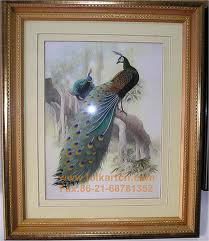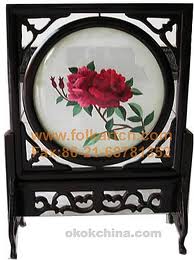China has always been famous for silk and silk embroidery by hand. For thousands of years, and known as the "Silk Road" brought Chinese silk and embroidery to Central Asia and West Asia, Europe and Africa. Silk trade created exchanges between China and Greece, India, Rome and worked as a link between these four ancient civilizations.
Since the tissue samples of 3000 BC the people closest to the achievement of China expressed its desire of human beings to enliven the surrounding environment and clothing, cosmetics and linens by adding hand work of some kind on the woven fabrics.
Different parts of the development of their own tactics. Type of thread, colors, shapes, and provide all the scope and style are unique. And each region was a few stitches unique to their style. Relate to the shapes of nature, religion and daily life of people.
Religious embroideries spanned the breadth of the age of many religious organizations and the royal courts. The sponsors of art and hand embroidery just like other art forms. These include the embroidery of gold or zardosi, chikankari, kasuti and Kashmir.
He said Chikankari impressed with the Turkish Although it is mentioned in the records of Megasthenes 3 in the eighth century BC, the Kashmiri embroidery is colorful with symbols like Chinar leaf, apple blossom, tulips, saffron flower and fauna in the region. The brightly colored flowers on Phulkari coarse cotton. Beadwork and Zardosi are introductions to the Mongols in the mirror and Business Model for Gujarat and Rajasthan. Embroidery Kantha 'of Bengal makes imaginative use of carpet waste and Kasuti famous for religious themes.
As the interview Suzhou embroidery (Su embroidery for short), Hunan embroidery (Xiang embroidery for short) and Sichuan embroidery (Shu embroidery for short) and Guangdong embroidery (U embroidery for short) are the four most famous styles of embroidery in China.
Suhou city is the center of hand-embroidered silk Chinese visual arts. From there the silk industry spreads west to other cities including Suzhou and extends to Shanghai, Wuxi, and others, and now includes Beijing, Guangxi, and Guangdong. Shenzhen, Zhejiang, Shanxi, Shandong, Hubei, Anhui and other places.
Silk and traditional hand embroidery alive. High quality work looks lifelike. I've created with loving care by the individual artist. These people are the masters of their trade.
They have incredible skill, and their stunningly beautiful. But it seems alive. The copying machine look harsh and unnatural. It is quite easily distinguishable.
The embroidery is hand-embroidered pure silk. It has exquisite, glossy feel to it. Real Madrid and can break when used silk thread in the sewing machine. So the thread that is used in the device is thicker and has a fiber artificial feel to it that it is the mix. Not from pure silk.
Chinese silk embroidery, and highly collectible. There are many collectors in Germany, and the rest of Europe and the United States, Japan, Africa and other countries, usually in the richness of art enthusiasts all over the world. Silk embroidered with a truly representative of Chinese art.
Authentic antique embroidered silk visual art sold for between $ 35000 to $ 125,000, and an excellent investment and prices continue to rise. Long-term (hundreds of years) has increased the value by up to 50 times. These pieces are displayed in museums and are in private collections and become available for sale in much the same way any art is not obsolete: dealers, auctions, and so on, with the usual problems of validity and verification of the source.
Double sided embroidery is a technique in which stitching takes place on both sides of the fabric of silk and transparent one. The design shows on both sides (front and reverse). Usually these are mounted on a piece of a wooden frame as a screen, one can really say which side is front or back.
Most of the embroidery, double sided, and almost all, and people see in the shops contain the same images on both sides. However, there are a few of the embroidery that double by the two different images on both sides. It's a mystery and a secret how to make this kind of business.
Have you ever seen such a beautiful painting on a piece of silk satin? Just imagine this embroidery threads with the exact number and needles! But embroidery is such a great and one of the forms of art in China is most famous for many centuries, and has established four major schools of embroidery techniques with the unique.










No comments:
Post a Comment